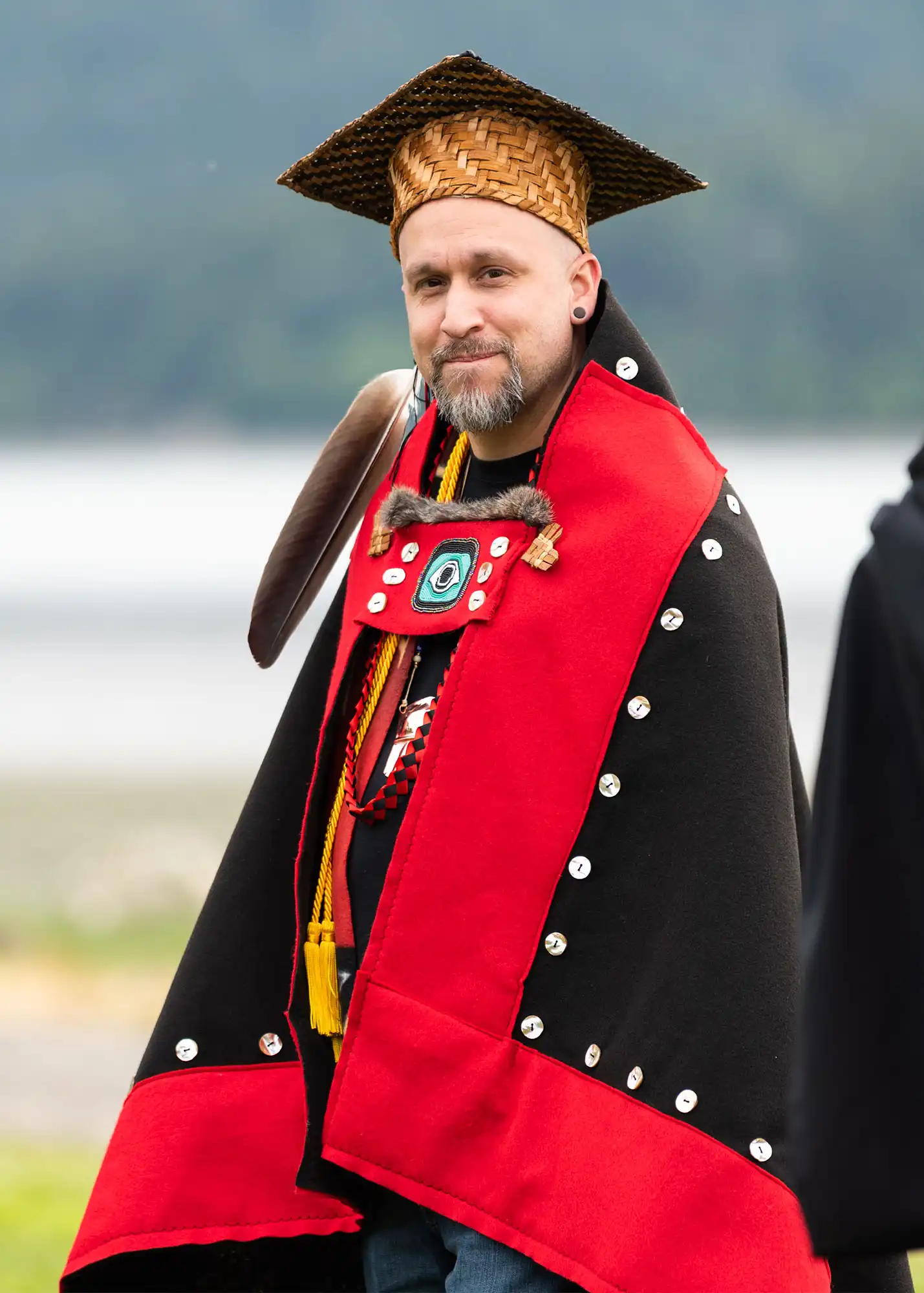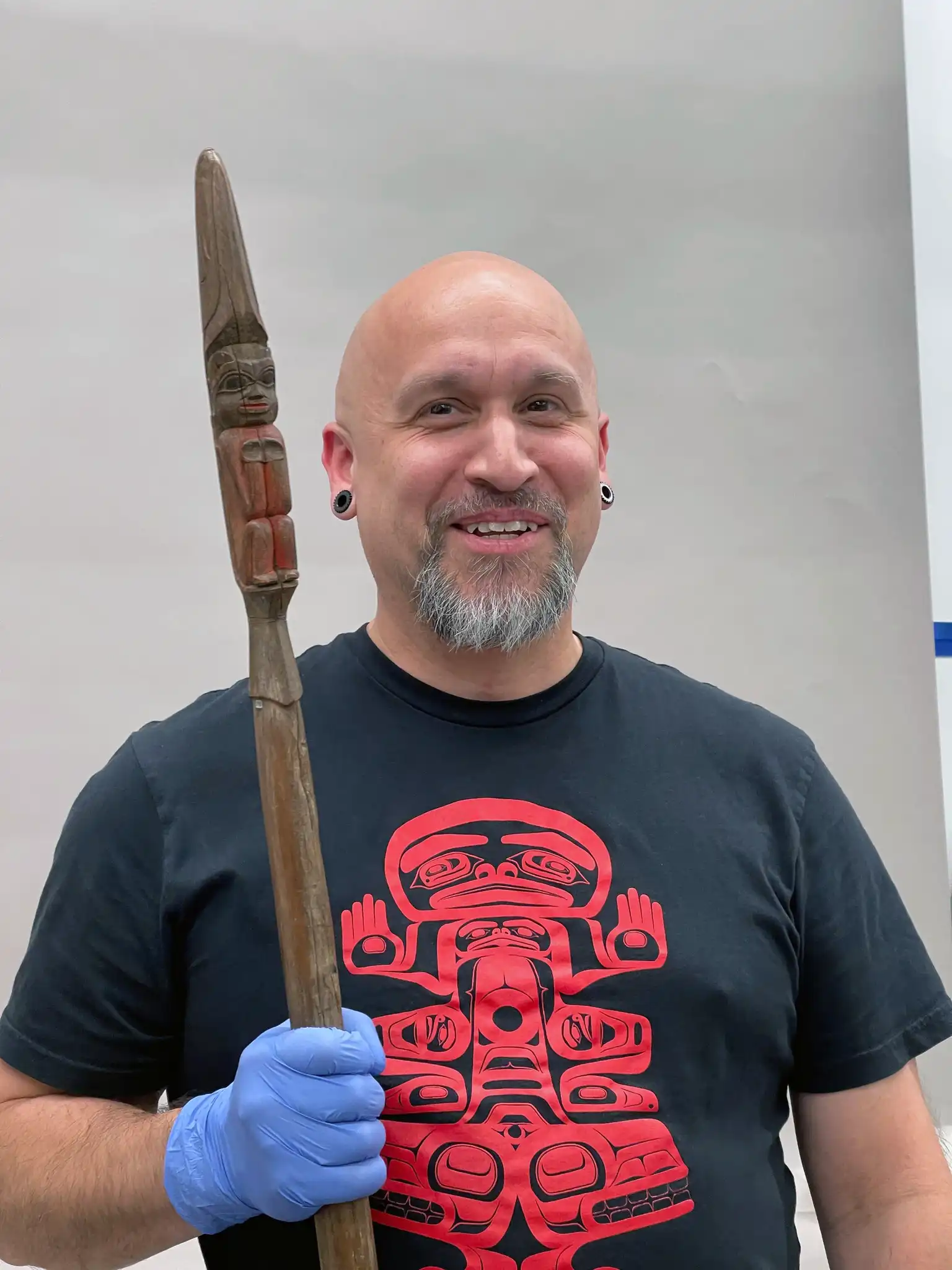About
Ancestors Apprentice

Hello, and gunalchéesh for visiting! I’m Kaa Shaayí, a Tlingit artist working to preserve and revitalize Northwest Coast Native Art through both traditional and contemporary expressions. My work spans teaching at Northwest Indian College, creating public murals throughout Washington State, conducting cultural research at institutions like the Burke Museum and Sheldon Jackson Museum, and organizing community initiatives. Whether I’m painting a 43-foot mural or teaching students about visual design languages, my goal is to create bridges between generations and cultures while honoring the sophisticated communication systems our ancestors developed.
My Journey
I spent my early years in Ketchikan, Alaska, surrounded by Kootéeyaa (totem poles) and Tlingit artwork, though my connection to Tlingit culture was initially limited. When my family moved to Ferndale, Washington at age 14, that distance from my cultural roots grew even wider. For years, I lived adjacent to my heritage without fully belonging to it.
I’ve been working in graphic design since 2009, which laid the foundation for my artistic practice. My deeper exploration of Formline art began as part of my journey to reconnect with my heritage. In 2020, during the pandemic isolation, I devoted intensive time to studying this traditional art form through online platforms and community connections.
Eager to build a stronger foundation, I enrolled at Northwest Indian College to pursue a Bachelor of Arts in Native Studies Leadership with an emphasis on Northwest Coast Design. I graduated with highest honors in 2024. This academic journey revealed both the rich cultural heritage of Native peoples and the profound ongoing impacts of colonization.
I’ve been fortunate to receive research grants from the Bill Holm Center at the Burke Museum in both 2022 and 2023. These opportunities allowed me to study historical Tlingit objects up close, deepening my understanding of traditional craftsmanship and early Formline decorated items. The hands-on experience with ancestral works has been invaluable in shaping my artistic perspective and techniques.
Today, my work bridges traditional Tlingit art forms with contemporary expression. I honor our ancestral traditions while addressing modern themes and using current materials. It’s my way of showing that Formline design is a living, evolving art form that remains deeply relevant in today’s world.
My Artistic Voice
My art is a conversation between past and present. Through Formline design, I work to preserve and evolve Tlingit artistic traditions, making them accessible and meaningful to contemporary audiences. Each piece I create is an opportunity to tell a story, to connect people with Tlingit culture, and to explore themes of identity, community, and cultural continuity.
I approach Formline not merely as decorative art, but as a complete communication system that conveys story, clan identity, property rights, and spiritual meaning. This sophisticated visual language functions much like written language does for other cultures. In my teaching at Northwest Indian College, I use Formline as a case study to help students from diverse tribal backgrounds understand how their own visual traditions operate as systems of cultural communication.
My connection to Tlingit culture is both a source of inspiration and an ongoing journey of discovery. While I’m Tlingit through my father’s lineage, Tlingit culture is strongly matrilineal. This has created unique challenges in establishing my identity as a Tlingit person. These experiences have given me insight into the struggles many others face who have patrilineal connections to tribal cultures.
This complexity inspired my signature “questioning eye” motif, which represents viewing the world from both Indigenous and contemporary perspectives simultaneously. It emerges from navigating cultural disruption and the breaking of my family’s knowledge about clan belonging. The questioning eye reminds me to hold multiple perspectives at once, honoring both where I come from and the world I move through today.
I believe that art has the power to educate, inspire, and heal. Whether I’m painting a large-scale mural or crafting a small piece, my goal is always to create work that invites viewers to engage with Tlingit culture and to consider the ongoing dialogue between traditional and modern ways of life.
Behind the Scenes on Patreon
This website showcases completed milestones and significant projects, the polished public face of my artistic practice. But there’s a whole other side to the work: the process, the learning, the cultural questions, the community organizing, and the raw thinking that happens between finished pieces.
That’s what lives on Patreon.
I post twice monthly about the theory of art and culture, specifically how visual design languages function as systems of identity, communication, and heritage. I use Tlingit Formline as a case study, but the principles apply across cultures. You’ll also see studio process and works in progress, teaching insights from my NWIC classes, cultural research updates, and real talk about building sustainable Indigenous futures.
Here’s the reality: most of my meaningful work is volunteer or severely underpaid. I teach because I’m passionate about the students and the mission. I co-founded Cedar Spirit Foundation to fund working adult Native students who fall through FAFSA gaps. I’m building Placemake Arts Northwest to establish Ferndale as a creative district. I serve on boards and organize community projects. But I have to spend most of my time generating income rather than dedicating real hours to this high-impact community work.
Patreon support shifts that balance. Your backing isn’t just funding art. It’s funding the time to build these initiatives properly, to continue teaching without financial stress, and to actually create and share the process. Monthly subscriptions help sustain the full ecosystem of work, from cultural preservation to Indigenous education to creative economic development.
New designs debut on Patreon before going to Alaska galleries, and monthly print tiers let collectors build a relationship with the practice beyond one-time purchases. If you want to follow the work more closely and support what makes it all possible, join me there.

Key Milestones
In 2024, I graduated with highest honors from Northwest Indian College with a Bachelor of Arts in Native Studies Leadership, emphasizing Northwest Coast Design. This formal education grounded my artistic practice in deeper cultural and theoretical frameworks.
I’ve created major public murals throughout Washington State, including the 43-foot “Ancestral Spirits” piece in Ferndale that brought Tlingit art into public space and sparked conversations about Native presence in the community. Each mural project allows me to scale traditional design principles to contemporary contexts while making Indigenous art more visible and accessible.
I designed the logo for the 2023 Leaders in Native Education Convening, which allowed me to represent three states through Formline elements. Graphic design projects like this demonstrate how traditional visual languages can speak powerfully in modern professional contexts.
I serve on the board of the Friends of Sheldon Jackson Museum in Sitka, Alaska, where I contribute to the preservation and promotion of Alaska Native art and culture. Through the International Coalition of Sites of Conscience program, I work to address the museum’s colonial legacy while supporting authentic Indigenous representation. This role keeps me connected to cultural institutions in my homeland.
I hold the position of Vice-Chair of the Ferndale Arts Commission, where I work to promote public art and cultural initiatives in my local community. This leadership role allows me to advocate for Indigenous artists and help shape how art serves our region.
Through teaching, research, public art, and community organizing, each milestone represents another step in the journey. I’m constantly working to deepen my understanding of Tlingit traditions and to find ways to make these traditions relevant and accessible in modern contexts.
Looking Ahead
As I look to the future, I’m excited about the possibilities to further develop my artistic practice and expand how Formline design speaks in various contexts. I’m particularly interested in more public art opportunities, as these projects have the power to make Tlingit art visible and accessible to wider audiences while transforming community spaces.
I’m preparing for a 2026 cultural pilgrimage to Southeast Alaska to study Formline art on historical totem poles in their original contexts and build relationships with practicing artists in Ketchikan, Klawock, and Sitka. This journey will deepen my understanding of Formline as lived practice rather than academic knowledge.
I’m also exploring “Hops & Heritage” brewery workshops that combine Formline painting instruction with cultural education in casual social settings. These events make cultural learning accessible while creating sustainable revenue that supports more community work.
Through all of this, my vision remains focused on cultural preservation that lives and breathes in the present, education that respects protocols while making knowledge accessible, and community work that builds sustainable Indigenous futures. The journey continues, one project at a time.
Mentions